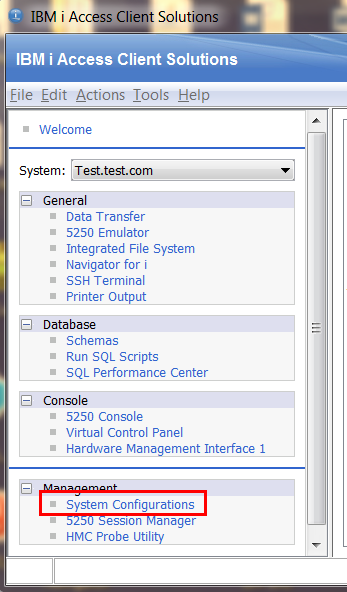
- #IBM I ACCESS CLIENT SOLUTIONS SYSTEM CONFIGURATION HOW TO#
- #IBM I ACCESS CLIENT SOLUTIONS SYSTEM CONFIGURATION PASSWORD#
- #IBM I ACCESS CLIENT SOLUTIONS SYSTEM CONFIGURATION PC#
- #IBM I ACCESS CLIENT SOLUTIONS SYSTEM CONFIGURATION DOWNLOAD#
In order to have a nicer experience and production-ready features, we will add the Spring Boot Actuator and add some new application configuration settings.

The start.sh script file contains the script to start the boottest application.The logs folder has the application log (log) and its rolling archive.The lib folder contains the JAR artifact gs-accessing-data-rest-0.1.0.jar built by Maven.The config folder is where the application.yml configuration file is located: ( ).Let’s take boottest app as an example in Qshell: /home/boottest Nevertheless, a Spring Boot app is usually deployed in a home folder that is organized as shown below. The default Maven build produces a Java executable JAR artifact that contains an embedded Servlet server (Tomcat). The application from part 1 could be JAR packaged with Maven and run as is on IBM i with “java -jar” in Qshell ( ). In addition, its syntax highlighting and JSON formatting is nice to the eye. For those used to wget or curl, the HTTPie usage is intuitive and natural. I have a preference for HTTPie because it is an easy-to-use command line. They both can be used to make REST requests in JSON format. On your PC, you will need this additional tool: We will be running the REST Spring Boot app on an IBM i server.

#IBM I ACCESS CLIENT SOLUTIONS SYSTEM CONFIGURATION HOW TO#
We’re building on part 1, How to Connect Spring Boot to the IBM Db2 for i Database.
#IBM I ACCESS CLIENT SOLUTIONS SYSTEM CONFIGURATION PC#
Data transfer allows you to transfer files to or from you PC for use in spreadsheets, and has been around for a long time.This is the second part of a series of technical articles about Java and IBM i integration. Uploading and downloading files does simply that - uploads or downloads a copy of the file.
#IBM I ACCESS CLIENT SOLUTIONS SYSTEM CONFIGURATION DOWNLOAD#
You can upload or download files with the IFS tasks or use data transfer. Section 9.1.33 in the Getting Started guide documents the IFS plugin for the command line interface.Īccess Client Solutions also allows you to transfer files between your IBM i and your PC. There is also the restriction in that you cannot move objects that reside in an independent ASP. The QPWDLVL system value must be the same on all partitions involved.
#IBM I ACCESS CLIENT SOLUTIONS SYSTEM CONFIGURATION PASSWORD#
You must be authorized to the listed set of commands, as well as having the same user profile with the same password on all IBM i partitions. Section 9.12 in the Getting Started guide documents the prerequisites and lists the commands used under the covers to copy or send the objects. There is an IFS plugin that allows you to copy and send objects, as well as the other IFS task actions, which would allow you to write scripts to automate moving objects around. I can use the IFS task in a similar manner to copy the desired objects from the large library to a second library on that partition, then easily send that second library to all of my other IBM i partitions.ĪCS has a command line interface that allows you to automate actions or initiate them without using the main ACS GUI panel. Let’s say I have a library with a lot of objects, and I want a subset of that library on my other partitions. The IFS task also provides an easy way to copy objects on a single partition. The screen capture below of the Send… dialog shows that you can select the destinations from your list of systems, as well as the options available. In addition, you can select multiple systems for the destination, sending the requested object to many partitions with a single request. Send…, which you will find under the View menu, has an option to send all objects, only new objects, or only existing objects. The Send… dialog has some additional, useful options. In addition to drag and drop, you can use copy/paste or send/receive objects between two IBM i partitions under the covers they all do basically the same thing. You can do this with stream files, objects in libraries (including save files), as well as library objects themselves. Now all you have to do is drag and drop the object from the source to the target. On the target partition, navigate to the directory where you want to store the object.

On the source partition, navigate to the directory where the object is stored – and remember that you can get to the QSYS.LIB file system through the IFS task. You can easily sidestep all this by using the ACS IFS task to send an object to another IBM i partition!įirst, open the IFS task on each partition. The IBM i Knowledge Center dedicates an entire section on data transfer methods and considerations when using FTP. FTP and Secure FTP are often used, but using FTP to transfer IBM i objects involves all sorts of complications. Perhaps you need to send a save file to another IBM i partition. The IFS task was introduced in ACS in July 2016, so this is not a new development, but it may not be widely known. Access Client Solutions’ IFS task makes it simple to copy or send objects. Sending objects from one IBM i partition to another is a common task. Guru: Move Objects with Access Client Solutions


 0 kommentar(er)
0 kommentar(er)
